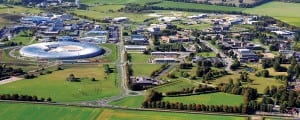Latest News
[Via Satellite 10-03-2014] When the United Kingdom first announced its goal to grow the country’s share of the global space industry to 10 percent, it garnered a lot of attention. Since that time, two satellite industry primes, Lockheed Martin and Thales Alenia Space have set up new divisions and are actively looking to build up a presence.
“We are really doing this to explore ways to partner with U.K. businesses and universities to explore some of the needs that the U.K. has in space,” Randy Sweet, director of business development for civil space at Lockheed Martin told Via Satellite. “The office will be managed by Lockheed Martin U.K., and we plan to set up our office at the Satellite Applications Catapult which is at the Harwell Science and Innovation campus in Oxfordshire.”
Sweet believes the U.K. stands out as a strong match for the technologies and services Lockheed Martin can provide. Some of the top markets the company intends to pursue are global security, small communications satellites, space exploration and environmental monitoring.
Lockheed Martin is no stranger to the U.K., having worked with Rutherford Appleton Laboratory (RAL) on sensors and satellite systems for some time. Still, the new initiative to create a space sector worth more than $64 billion by 2030 has served as an additional catalyst. For the U.K. Space Agency, the growing industry interest is a source of confidence on their mission.
“This will require an expansion of space players of all sizes, including primes, so these inward investments are in line with the U.K.’s broad strategy for growth,” said Colin Baldwin, U.K. space gateway program manager at the U.K. Space Agency. “We are keen to see inward investment in particular in areas that add to U.K. capabilities — for example those that address gaps in our existing supply chains or that open up new market opportunities.”
Sweet said Lockheed Martin is looking to aid space agencies in creating mission architectures that leverage the company’s experience in programs such as space exploration. For example the company built the Mars Atmosphere and Volatile Evolution (MAVEN) satellite, and is also working extensively on the Orion spacecraft, both of which are NASA projects. One particularly interesting market that could open up would be conducting launches from the upcoming U.K. spaceport. This is something Lockheed Martin is interested in, according to Sweet.
“We have a lot of capability in launch and lift, so bringing all of those together to meet the needs of the U.K. is what we are looking at,” he said. “We are well positioned to partner with the U.K. to enable responsive and reliable access to space. Combined with the focus the U.K. has on small satellites and payloads, that could be a nice match for Lockheed Martin.”
Lockheed Martin is well known for its Atlas 5 rocket but the company has also resurrected the Athena SmallSat launcher in hopes of capturing business from the growing SmallSat sector. The Athena rocket can already launch from NASA’s Wallops Mid-Atlantic Regional Spaceport in Virginia, Vandenberg Air Force Base, Calif., Cape Canaveral, Fla. and the Kodiak Launch Complex in Alaska. Excited by the potential for SmallSats in the U.K., a spaceport there could add a fifth option.
But, according to Baldwin, the U.K. Space Agency is apprehensive about standard vertical launch systems.
“The work undertaken to date by the U.K.’s Civil Aviation Authority has focused on a U.K. spaceport for horizontal launches. However, they have also reviewed the pros and cons of co-locating vertical launch capabilities (for polar orbit launches only) to address the markets that horizontal launch vehicles will be unable to address.”
If the spaceport were to co-locate both a vertical and a horizontal launch capability, it would significantly cut down on infrastructure costs. The challenge, Baldwin said, is that the needs of vertical launch systems differ significantly from horizontal systems. To justify having both systems, a vertical launch provider would need to have a convincing argument for why it would be a good business decision.
“Given that the long-term goal is to replace vertical launch with more efficient spaceplanes, investing in a separate vertical launch site would require a compelling case from a vertical launch operator that it could, even as a conventional rocket launch system, significantly reduce costs and offer satellite operators a good choice of launch slots,” added Baldwin.
These and other options are some of the decisions the U.K. Space Agency will have to make as it charts out a plan to quadruple space sector revenue. The agency is also looking to see more space startups and growing involvement from small-to-medium enterprises. As companies such as Lockheed Martin, Thales and Airbus strengthen their presence, Baldwin counts their activity as a good indicator of health.
“On a broader note, primes moving into the U.K. send a strong signal that there is increasing momentum and confidence in the U.K. space sector,” he said. “It reaffirms our stance that the U.K. is ‘the place for space’ and reinforces our combined efforts to grow the sector.”
Get the latest Via Satellite news!
Subscribe Now